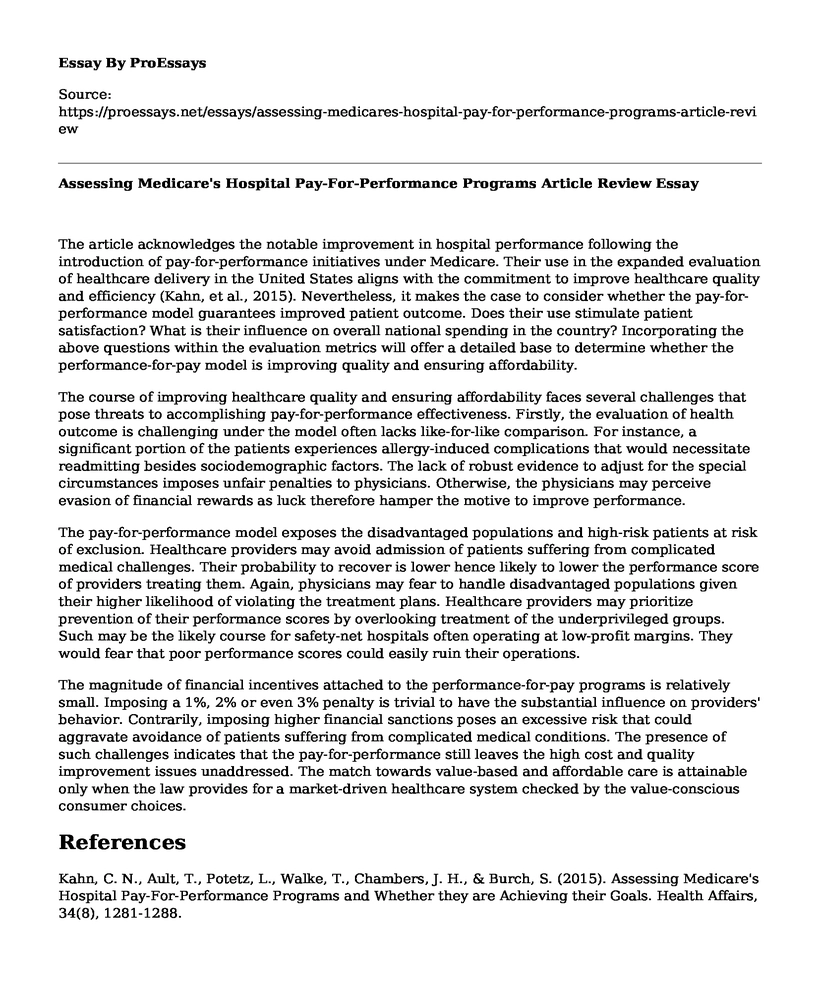The article acknowledges the notable improvement in hospital performance following the introduction of pay-for-performance initiatives under Medicare. Their use in the expanded evaluation of healthcare delivery in the United States aligns with the commitment to improve healthcare quality and efficiency (Kahn, et al., 2015). Nevertheless, it makes the case to consider whether the pay-for-performance model guarantees improved patient outcome. Does their use stimulate patient satisfaction? What is their influence on overall national spending in the country? Incorporating the above questions within the evaluation metrics will offer a detailed base to determine whether the performance-for-pay model is improving quality and ensuring affordability.
The course of improving healthcare quality and ensuring affordability faces several challenges that pose threats to accomplishing pay-for-performance effectiveness. Firstly, the evaluation of health outcome is challenging under the model often lacks like-for-like comparison. For instance, a significant portion of the patients experiences allergy-induced complications that would necessitate readmitting besides sociodemographic factors. The lack of robust evidence to adjust for the special circumstances imposes unfair penalties to physicians. Otherwise, the physicians may perceive evasion of financial rewards as luck therefore hamper the motive to improve performance.
The pay-for-performance model exposes the disadvantaged populations and high-risk patients at risk of exclusion. Healthcare providers may avoid admission of patients suffering from complicated medical challenges. Their probability to recover is lower hence likely to lower the performance score of providers treating them. Again, physicians may fear to handle disadvantaged populations given their higher likelihood of violating the treatment plans. Healthcare providers may prioritize prevention of their performance scores by overlooking treatment of the underprivileged groups. Such may be the likely course for safety-net hospitals often operating at low-profit margins. They would fear that poor performance scores could easily ruin their operations.
The magnitude of financial incentives attached to the performance-for-pay programs is relatively small. Imposing a 1%, 2% or even 3% penalty is trivial to have the substantial influence on providers' behavior. Contrarily, imposing higher financial sanctions poses an excessive risk that could aggravate avoidance of patients suffering from complicated medical conditions. The presence of such challenges indicates that the pay-for-performance still leaves the high cost and quality improvement issues unaddressed. The match towards value-based and affordable care is attainable only when the law provides for a market-driven healthcare system checked by the value-conscious consumer choices.
References
Kahn, C. N., Ault, T., Potetz, L., Walke, T., Chambers, J. H., & Burch, S. (2015). Assessing Medicare's Hospital Pay-For-Performance Programs and Whether they are Achieving their Goals. Health Affairs, 34(8), 1281-1288.
Cite this page
Assessing Medicare's Hospital Pay-For-Performance Programs Article Review. (2022, Mar 29). Retrieved from https://proessays.net/essays/assessing-medicares-hospital-pay-for-performance-programs-article-review
If you are the original author of this essay and no longer wish to have it published on the ProEssays website, please click below to request its removal:
- Paper Sample on Importance of Organizational Change and Employees Engagement
- Paper Sample: Complexities and Risks that Face Multinational Corporations
- Management Essay Example: Phases in Implementing Change
- Importance of Data in Decision-Making Essay
- Paper Example on Modern Rangers: Ethics and Leadership
- Paper Example on Joy Inc.: Building a Successful Organization in a Competitive, Tech-Driven World
- Essay Example on Poorly Articulated Goals/Objectives: Impact on Public Health Programs







